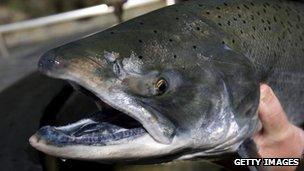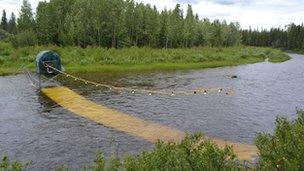Alaska and the mysterious disappearing king salmon
- Published
.jpg)
Subsistence fisherman Michael Winter collects a king salmon caught in his fishing wheel in Chitina, Alaska, before releasing it back to the Copper River
When the number of king salmon running in Crooked Creek's river declined dramatically, the mostly native Alaskan villagers were left wondering where they could find enough food to last the winter.
Crooked Creek has no big-box grocery stores or roads to other towns. But in good times, the Kuskokwim River promises king salmon to the villages along its 702 miles (1,130km).
But good times are fading into memory for villagers like Evelyn Thomas, who has lived in Crooked Creek her entire life.
"In my language, fish is called 'the food'," says Thomas, a half Yupik, half Athabascan native Alaskan who says she has little money to buy food to replace the salmon.
"When we don't get 'the food', a staple of our diet is missing."
Over the past five years, Alaska's king salmon have begun to disappear from the state's rivers, and no-one is sure why.
This summer's king salmon season yielded one of the lowest catches on record. The drop has devastated commerce and tourism, but the most dramatic effect has been on subsistence villages where fishermen eat what they catch.
In an emergency effort to ensure the future survival of the king salmon, state officials have severely limited the catch this year, even going so far as to close some rivers entirely to fishermen.
Fishermen accused of breaking the limit have been prosecuted, their catch confiscated.
"Many people don't know how they're going to feed their families throughout the winter," says Thomas. "There is no economy here, there is no money."
Crooked Creek is part of one of the poorest regions in the US, the Yukon-Kuskokwim delta in Alaska's south-west.
The delta's rural villages suffer from chronic unemployment and some of the highest poverty rates in the country - up to 31%, compared to 15% nationwide.

King salmon is also known as chinook salmon
The cost of living there is exorbitant, because the area has few roads. Petrol and other supplies must be imported by barge or plane.
But one king salmon can feed an entire family for a week.
The fish ranges from a glittering silver in colour to a bold red, but its most distinctive trait is its size. Fishermen in villages like Crooked Creek wade in the Kuskokwim River to catch king salmon in their nets.
They hang their catch on racks to dry and preserve it for the winter. Families can the salmon and make smoked boiled salmon during the winter. Or they freeze the salmon and fry or bake it.
The salmon's rich flavour and oil nourish families through the long, dark winter.
But this year, the delta's fishermen hauled in less than a quarter of the usual harvest of 80,000 king salmon, according to the Association of Village Council Presidents.
"Many people in the villages will have to choose between food and fuel this winter," says Myron Naneng Sr, president of the association.
The reason for the drop remains unclear, says Pat Shields, a biologist with the Alaska Department of Fish and Game.
"There's a concern about kings in Alaska right now - very few rivers have achieved king spawning escapement goals," he says.
"We're in the third, fourth, fifth year of this now - what's happening? We have made our spawning goals in systems and we're not getting the adults back."
Since most of Alaska's prime salmon rivers have suffered large declines, scientists are searching further downstream, in the ocean for clues. Researchers have no sense of when - if ever - the salmon will recover.
Alaska's economic vitality is tied to the health of its king salmon, and anxiety over the fish's fate is felt particularly strongly on the Kenai Peninsula.
The Kenai River's turquoise waters thread past the small fishing towns of Soldotna and Kenai, which are normally packed with tourists during the summer months.
So in July, when authorities closed the Kenai River to sport king-fishing for the first time in the state's history, the economic impact was devastating.
"In the last three or four years, Alaska's tourism industry has felt the economic downturn just like any other region in the country and world," says Ricky Gease, executive director of the Kenai River Sportfishing Association.
"Many businesses here have gone through their savings, and it's getting to the point where an event like this is the last straw that breaks the camel's back."
Even commercial fisherman hunting other species have been sidelined this summer.
The state restricted commercial fishing of sockeye salmon, a different species, in the Cook Inlet in order to minimise the number of king salmon netted inadvertently.
"You got one of the longest in-place sustained fisheries in the state [that's] being threatened," says Gene Palm, a commercial fisherman.
"Our future is tenuous to say the least."
The restrictions have escalated long-held tensions among the many groups reliant on king salmon.

Counting towers are used in addition to sonar counts to record salmon returns in Alaska.
Native Alaskan subsistence communities feel they have unfairly borne the burden, compared to the large commercial fisheries.
"We're not allowed to practise the human right to feed our families," says Thomas. "Close all commercial fishing [and] people will holler and scream. But we don't make any money on anything - we use it to eat. And we've been hit the hardest."
Officials estimate the loss to the state from this summer's weak catch could exceed $10m (£6m), and the US government hopes to offer financial assistance to subsistence villagers and commercial fishermen alike.
But with fresh snow already falling on the mountains ringing Crooked Creek, Thomas isn't waiting on government assistance: she has applied for a moose-hunting permit and is gathering berries.
"My parents, when I was small, used to tell me, 'It's easier to lose a little sleep now in the summer months when the food is here, than it is to feel the pinch of hunger in April and May,'" Thomas says.
"Looking back on it, they were absolutely right. This year is going to be pretty tough."
- Published26 October 2010